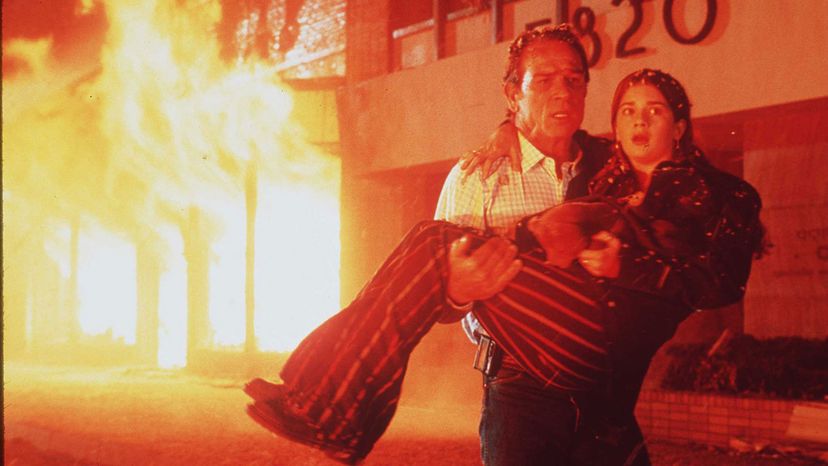
Image: "Volcano" movie/Hulton Archive/Getty Images
About This Quiz
Ah, the '90s. We're still watching this glorious decade's campy disaster flicks for the action scenes and nostalgic value. But accuracy was never their forte. Just for kicks, let's look at the science of "Twister," "Volcano" and more.
How does "Twister" misrepresent the Fujita scale, a real-life tornado rating system?
It doesn't pertain to North American tornadoes.
Tornadoes don't get ratings until after they've ended.
You can't just look at a swirling tornado and call it an "F-3" on the spot, like Allan Sanders does. Ratings are only given once experts have retroactively assessed the damage.
Characters talk about F-5 tornadoes, which don't really exist.
Why doesn't Los Angeles get volcanic eruptions like the one that devastates the city in "Volcano"?
LA doesn't have the right tectonic conditions for volcano formation.
Volcanoes arise near tectonic subduction zones or at geological "hot spots." But there are no such features around the City of Angels.
All the local volcanoes are dormant.
Californians passed a state-wide volcano ban in 1973.
In real life, when would an Earth-bound, Texas-sized asteroid (like the one in "Armageddon") become visible to the naked eye?
About 10 days before impact.
About two weeks before impact.
Well over a month before impact.
Despite this, nobody in the movie notices the giant object until just 18 days before its projected arrival.
Advertisement
Fill in the blank: James Cameron revised the sinking scene in "Titanic" when astrophysicist Neil DeGrasse Tyson told him ____________.
The starfield was inaccurate.
Rose gazed on an impossible arrangement of stars in the original version of the movie. Not to worry: Tyson helped Cameron fix this for the 3D re-release.
The moon was in the wrong phase overhead.
The actual ship went down at dusk, so twilight would've been visible.
Experts praised some aspects of "Dante's Peak," but many also criticized the famous acid lake scene in this 1997 volcano movie. Scientifically, what was wrong with it?
Pierce Brosnan's boat should've instantly dissolved.
Acidic lakes have nothing to do with volcanoes.
The lake's acidity escalated way too fast.
Volcanic activity can render some lakes quite acidic. That much is true. However, the process takes more time than "Dante's Peak" suggests.
True or False: Tsunamis - like the ones seen in "Deep Impact" - slow down when they go from deep to shallow water.
TRUE
The phenomenon is called "shoaling." And it also accounts for the fact that tsunami waves get taller in the shallows. This one, the movie got right.
FALSE
Advertisement
In "Godzilla" (1998), Manhattan's besieged by a giant lizard who reproduces asexually. Which of these reptiles can use the same trick?
the Komodo dragon
the green anaconda
both of the above
Virgin births have also been documented in Burmese pythons, a species that's become popular in the exotic pet trade.
To split that giant asteroid in "Armageddon," the math suggests you'd need a bomb more than a billion times more powerful than which of these weapons?
the American bomb used in the 1945 Trinity nuclear test
the Soviet Union's famous "Big Ivan" bomb
Officially called Tsar Bomba, Big Ivan released 418,000 terajoules of energy when it was detonated in 1961. That was the biggest man-made explosion of all time. Physics students estimated the "Armageddon" asteroid would require 800 trillion terajoules of energy, so Bruce Willis wouldn't have been able to save mankind by detonating an H-bomb on its surface and splitting it before it hit Earth.
"Little Boy," the atomic weapon dropped on Hiroshima in 1945
True or False: The Dorothy device from "Twister" was based on a real contraption.
TRUE
The screenwriters drew inspiration from the barrel-shaped TOtable Tornado Observatory (or "TOTO"), a data-gathering instrument tested in the 1970s and 1980s.
FALSE
Advertisement
"Independence Day" opens with a present-day shot of an Apollo-era U.S. flag astronauts planted on the moon. What was wrong with the shot?
The flag was flapping in the breeze.
The flag still showed red, white and blue.
Scientists suspect that getting hit by unfiltered UV radiation from the sun - for decades on end - has most likely burned off the colors.
It looked as good as new.
You Got:
/10
"Volcano" movie/Hulton Archive/Getty Images